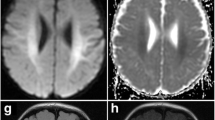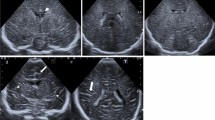Abstract
Canavan disease is a rare hereditary leukodystrophy that manifests in early childhood. Associated with rapidly progressive clinical deterioration, it usually results in death by the third year of life. The predominant MRI appearance is diffuse and symmetrical white matter disease. We discuss an atypical, late presentation of Canavan disease with a benign clinical course and uncharacteristic imaging features. This case introduces a previously unreported pattern of diffuse cortical abnormality without significant white matter involvement.


Similar content being viewed by others
References
Feigenbaum A, Moore R, Clarke J (2004) Canavan disease: carrier-frequency determination in the Ashkenazi Jewish population and development of a novel molecular diagnostic assay. Am J Med Genet A 124:142–147
Matalon R, Michals-Matalon K (1993) Canavan disease. In: Pagon RA, Adam MP, Bird TD et al. (eds) GeneReviews, Seattle, WA
Mathew R, Arun P, Madhavarao CN et al (2005) Progress toward acetate supplementation therapy for Canavan disease: glyceryl triacetate administration increases acetate, but not N-acetylaspartate, levels in brain. J Pharmacol Exp Ther 315:297–303
Barkovich AJ, Raybaud C (2012) Pediatric neuroimaging. Wolters Kluwer Health/Lippincott Williams & Wilkins, Philadelphia
Baslow MH, Guilfoyle DN (2013) Canavan disease, a rare early-onset human spongiform leukodystrophy: insights into its genesis and possible clinical interventions. Biochimie 95:946–956
Leone P, Shera D, McPhee SW et al. (2012) Long-term follow-up after gene therapy for canavan disease. SciTransl Med 4:165ra163
Janson CG, Kolodny EH, Zeng BJ et al (2006) Mild-onset presentation of Canavan’s disease associated with novel G212A point mutation in aspartoacylase gene. Ann Neurol 59:428–431
Velinov M, Zellers N, Styles J et al (2008) Homozygosity for mutation G212A of the gene for aspartoacylase is associated with atypical form of Canavan’s disease. Clin Genet 73:288–289
Conflicts of interest
None
Author information
Authors and Affiliations
Corresponding author
Rights and permissions
About this article
Cite this article
Nguyen, H.V., Ishak, G.E. Canavan disease – unusual imaging features in a child with mild clinical presentation. Pediatr Radiol 45, 457–460 (2015). https://doi.org/10.1007/s00247-014-3116-8
Received:
Revised:
Accepted:
Published:
Issue Date:
DOI: https://doi.org/10.1007/s00247-014-3116-8




